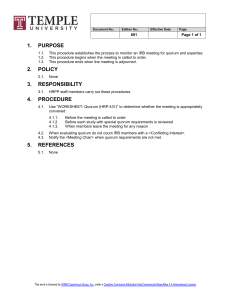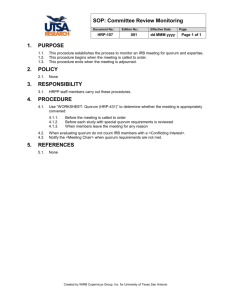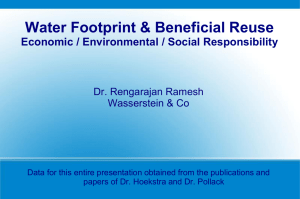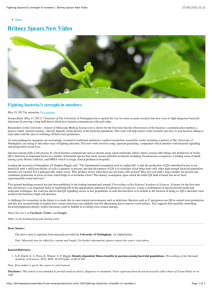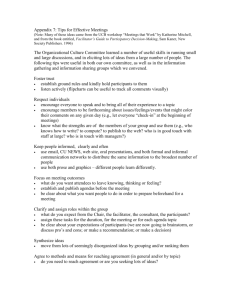Examining quorum sensing through acute environmental control Abstract
advertisement
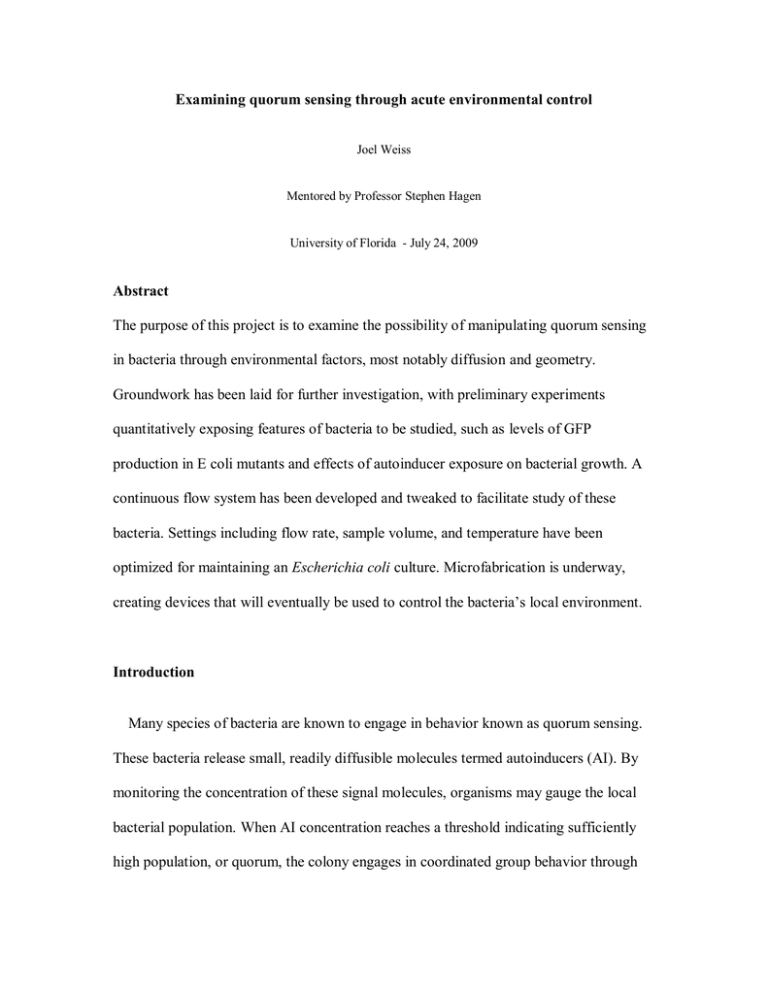
Examining quorum sensing through acute environmental control Joel Weiss Mentored by Professor Stephen Hagen University of Florida - July 24, 2009 Abstract The purpose of this project is to examine the possibility of manipulating quorum sensing in bacteria through environmental factors, most notably diffusion and geometry. Groundwork has been laid for further investigation, with preliminary experiments quantitatively exposing features of bacteria to be studied, such as levels of GFP production in E coli mutants and effects of autoinducer exposure on bacterial growth. A continuous flow system has been developed and tweaked to facilitate study of these bacteria. Settings including flow rate, sample volume, and temperature have been optimized for maintaining an Escherichia coli culture. Microfabrication is underway, creating devices that will eventually be used to control the bacteria’s local environment. Introduction Many species of bacteria are known to engage in behavior known as quorum sensing. These bacteria release small, readily diffusible molecules termed autoinducers (AI). By monitoring the concentration of these signal molecules, organisms may gauge the local bacterial population. When AI concentration reaches a threshold indicating sufficiently high population, or quorum, the colony engages in coordinated group behavior through selective gene regulation. Common examples of these AI responses include bioluminescence in Vibrio fischeri (V. fischeri), the formation of biofilms in Pseudomonas aeruginosa, and expression of virulence factors in Staphylococcus aureus [1]. A better understanding of quorum sensing opens the possibility of manipulating behaviors such as virulence in some bacteria. Most quorum sensing controlled behaviors are only beneficial when a sufficiently large population of bacteria works in harmony. However, some others have no obvious group benefit. This has led to an alternate interpretation of quorum sensing termed diffusion sensing [2]. It has been conjectured that by monitoring concentrations of their own AI, the bacteria gain knowledge of the diffusive properties of their local environment. This allows for regulation of the production of molecules such as degradative enzymes which depend on diffusion for optimal operation and cell function. In order to test whether cells can react specifically to their immediate surroundings, microfluidic devices will be used, providing full control of the cells' environments [3]. Device parameters such as geometry will be used to manipulate local diffusive properties, and therefore the quorum sensing behavior, of these cells. Microfluidic devices are well suited to the task of quantitative operation due to the ease with which variables are controlled. By virtue of their scale, these devices allow precise control of independent variables. Flow rate is dependent on fluid input, which is controlled through syringe pumps making fluid dynamics predictable. In the regime of microfluidics, laminar flow is the norm, and highly customizable gradients of molecular concentrations within these flow patterns can be achieved through mixing devices. Most other variables such as temperature are likewise precisely controllable [4]. Microfluidic Considerations Devices that will allow manipulation of AI diffusion are first designed with a Computer Aided Design (CAD) program. Device features have resolution slightly sharper than 25um. Fabricating these devices requires photo lithography which entails the following procedure: Two dimensional device designs are plotted on transparency films. In a clean room, silicon wafers are spin coated with a photoresist material; its thickness, and thus the depth of microfuidic channels, is controlled by rotational speeds. The coated wafer is then exposed to UV light shone through the transparency film and washed in developer solution. All photo resist exposed to the light source washes away, leaving a raised impression of a positive mask's design on the silicon wafer. This is used as a master mold. Polydimethylsiloxane (PDMS) is poured onto the wafer. After baking, the now solidified PDMS is carefully peeled off, leaving the master mold's impression in the PDMS block. A glass cover slip can be permanently bound to the device's surface after exposure to oxygen plasma [5]. This PDMS-cover slip combination is a watertight microfluidic device ready for use. Bacteria suspended in broth can then be loaded through holes drilled into the PDMS. Syringe pumps allow for precise control of fluid input, with flow rates as low as .001mL/hr. These devices provide the ideal environment for biological studies due to the level of control available in their design and function. In addition, PDMS is impermeable to water, but permeable to gas, making it well suited for use in bioassays. Multi layered PDMS devices have even been designed by others with valves, pumps, and complex bacterial chambers [6]. Bacterial Strains Bacterial strains used for this study include two Escherichia coli (E. coli) mutants into which quorum sensing genes have been inserted by other laboratories. The first, strain MT102 with plasmid pJBA132, responds to externally added AI by producing green fluorescence protein (GFP) which can be quantitatively measured. This strain does not produce AI itself, allowing researchers to assess the GFP response of E. coli mutants to selected AI concentrations. Figure 1 shows the fluorescent response of MT102 cells to various concentrations of AI. Note that a sharp increase in GFP production occurs as AI concentration rises, with diminishing returns at higher concentrations. This is commonly interpreted as a sort of switch in the behavior of the bacteria, once quorum is reached. Figure 1. Fluorescence is normalized to optical density, a measure of cell density. A larger population has more GFP producers and thus higher fluorescence; normalization makes these data points open to comparison. The graph demonstrates the effect of AI concentrations on GFP production. The second strain, MC1061 with plasmid pAC-luxGFP, harbors an entire quorum sensing circuit, both detecting AI and manufacturing it, with GFP production the result of quorum. This strain behaves similarly to the model quorum sensing bacteria V. fischeri, whose wild type strain carries the original Lux I/R quorum sensing circuit being studied. V. fischeri produce bioluminescence in response to AI detection. Capturing photons emitted by small bacterial populations is tedious and unreliable, so the easily measured fluorescence of these mutant E. Coli provides a more suitable method for gaging quorum sensing behavior. Fluorescence When excitation light strikes a molecule, electrons rise to an excited state. Upon returning to their ground state, these electron emit a photon, generally of a longer wavelength due to energy lost through various outlets. This is the basic mechanism of fluorescence. In practice this provides a simple and reliable quantitative measurement, as devices devised for fluorimetery yield detailed information about the fluorescent nature of samples. Figure 2 shows an emission spectrum of GFP from an E coli sample with AI concentration of 25nM, measured in a Jasco FP750 Spectofluorimeter. Figure 2. GFP emission spectrum from MT102 E coli with gene pJBA132 at an AI concentration of 25nM with an excitation wavelength of 475nm. The tail seen at 485nm is due to a large excitation bandwidth and is simply scattered excitation light picked up by the emission sensor. In taking measurements, samples are first centrifuged, producing a cell pellet deposition at the bottom of a centrifuge tube, pulled from the growth medium. The supernatant is then removed. This "cell washing" is necessary due to the fluorescent nature of broth used for culturing E coli (Luria-Bertani broth was used throughout these experiments). The pellet is then re-suspended in a transparent fluid (phosphate buffer at 7.0 pH). The mixture is placed in a quartz vial optically transparent to all visible wavelengths, and fluorescent measurements can be taken. GFP is a protein which experiences greatest excitation from blue light (around 475nm wavelength) and emits green light (wavelengths in the lower 500nm range). Greater intensity of the spectrum indicates greater quantities of GFP. A large variety of GFPs exist and are used frequently in biological experiments as indicators of dependent variable response. Some forms of GFP have a short peptide tail added to their original chain which allows naturally present bacterial proteases to destroy the protein. This gives the GFP a half-life of around forty minutes in E. coli and makes it a better indicator of a cell's current behavior [7]. GFP has been tied to the quorum sensing mechanism in the bacteria used for this study through genetic engineering; thus, GFP is produced when AI is detected. It allows for a direct assessment of quorum sensing in these bacteria. Continuous Flow The GFP variety produced in MC1061, the E coli strain harboring an entire quorum sensing circuit, is not short lived. Issues quickly arose where any colony started from an older, more densely developed one, produced large initial fluorescent signals, as the starting bacteria had been quorum sensing prior to their use in the new culture, and were already teaming with GFP. To counter this issue, a continuous flow system was devised. The continuous flow system constantly adds fresh growth medium to a sample, while simultaneously removing the same volume. The sample volume remains constant, but some bacteria are washed out. By matching the rate of bacterial dilution to bacterial growth speeds, cultures may be kept continuously growing in exponential phase, while maintaining a constant density insufficient for quorum sensing. "Waste" pumped out of the system is directed through a flow cell (a quartz, optically transparent vial with two open ports allowing sample waste flow) placed in a spectrophotometer. In this way, the sample’s optical density (OD) is constantly monitored, providing a convenient measure of cell density at low bacterial concentrations. The continuous flow sample can then be used to begin experiments, with the advantage of precisely knowing the cells' entire history, with no initial quorum sensing spurring GFP production. Bacterial growth is exponentially sensitive to temperature, so reaching equilibrium in the continuous flow system requires constant temperature control. More importantly, reproducibility of results depends heavily on accurate temperature monitoring. To solve both of these issues, samples (including the continuous flow system) are housed inside a custom-made aluminum heating block. The block maintains cultures at 37C, the optimum temperature for E coli growth. Figure 3 shows a CAD drawing of the heating block created. Figure 3. Original CAD drawing of the heat block created. The block is aluminum and features a sample holder, hot water inlet and outlet, and a thermometer slot for monitoring temperature. A water cooling system regulates temperature and maintains a steady flow of 37C water to heat the block. Direction of Further Study The foundation for further studies has been laid in the past ten weeks. Data obtained will aid interpretation of future measurements. Fluorescent intensities can be put into a meaningful context, and measurements of E. coli growth in specific lab settings provide a controlled reference for planning further studies. Microfluidic device fabrication has just begun, and the devices will be put to use as soon as possible, first to assess the feasibility of the environmental manipulation intended and finally to influence quorum sensing. Numerous experimental designs have been planned. One of particular interest is the isolation of a single bacterium in a small PDMS chamber; in this scenario, the cell might build up AI and induce its own quorum. Imposing varying levels of diffusion on different bacteria groups to gauge how quorum sensing is affected will also be atempted. Acknowledgments I would like to thank Dr. Stephen Hagen for his oversight and guidance in my first research experience. In addition, I would like to thank Minjun Son for his help in conducting the experiments, along with Johnathan Young and Pablo Perez for their help with all lab processes. Finally, I would like to thank Dr. Selman Hershfield, the UF Physics REU program, and NSF for funding and providing this amazing opportunity. [1] B. L. Bassler, Current Opinion in Microbiology 2 (6), 582-587 (1999). [2] R. J. Redfield, Trends in Microbiology 10 (8), 365-370 (2002). [3] S. K. Sia, G. M. Whitesides, Electrophoresis 24 (21), 3563-3576 (2003). [4] P. J. Hung, P. J. Lee, P. Sabounchi, et al. Biotechnology and Bioengineering 89 (1), 1-8 (2005). [5] S. R. Oh, Journal of Micromechanics and Microengineering 18 (11), 115025 (2008). [6] Marc A. Unger, Hou-Pu Chou, Todd Thorsen, Axel Scherer, and Stephen R. Quake, Science 288 (5463), 113 - 116 (2000). [7] J. B. Andersen, C. Sternberg, L. K. Poulsen, et al, Applied and Environmental Microbiology 64 (6), 2240-2246 (1998).
